Investigating the Effect of Network Standards on Improving Internet Access in Multi-Dwelling Units
Investigating the Effect of Network Standards on Improving Internet Access in Multi-Dwelling Units
Blog Article
Network standards play a vital role in improving web connectivity, especially in multi-dwelling units (MDUs) like apartment complexes and condominiums. These standards define how data is communicated over networks, ensuring that equipment can communicate efficiently. As an increasing number of individuals rely on the web for work, learning, and entertainment, having a dependable and high-speed connection in MDUs has become progressively important. By understanding Ethernet protocols, property managers and residents can make knowledgeable choices about their web services, resulting to better access for all.
One of the key Ethernet standards is IEEE 802.3, which details the specifications for wired Ethernet connections. This specification has developed over the years, introducing quicker rates and enhanced efficiency. For example, the original Ethernet specification offered speeds of 10 megabits per sec, while newer iterations, such as Gigabit Ethernet, can provide speeds of up to 1,000 megabits per second. In MDUs, where numerous tenants share the same internet link, having a rapid Ethernet system can greatly improve the overall user interaction. Quicker rates mean quicker downloads, more seamless broadcasting, and greater video calls, which are essential for remote employment and virtual education.
Another important feature of Ethernet standards is the implementation of organized cabling systems. These structures organize and manage the system cables that link devices within a building. By following the principles set by Ethernet protocols, MDUs can ensure that their cabling is efficient and effective. This structure assists minimize interference interference and improves information transfer standards. Additionally, structured cabling allows for easier improvements and maintenance, allowing it easier for building administrators to adapt to changing technology needs. As internet utilization persists to grow, having a well-structured wiring infrastructure is crucial for ensuring high-quality access.
Electricity over Ethernet (PoE) is another significant development in Ethernet technology that benefits MDUs. PoE allows network cables to transmit electrical electricity together with data, eliminating the requirement for individual power sources for devices like security cameras, Wi-Fi access points, and VoIP phones. This feature simplifies installation and reduces clutter, making it easier to set up a comprehensive network in multi-dwelling units. By leveraging PoE, building administrators can improve mdu internet troubleshooting safety and boost web access throughout the complex without the extra cost of extra power work.
In summary, Ethernet protocols have a profound impact on web access in multi-dwelling buildings. By offering faster speeds, organized cabling, and innovative capabilities like Power over Ethernet, these standards assist create a reliable and effective network for residents. As tech continues to advance, remaining informed about Ethernet protocols will be crucial for property managers and residents alike. By investing in the appropriate infrastructure, MDUs can ensure that all tenants enjoy a smooth web experience, making their residences more connected and accessible.